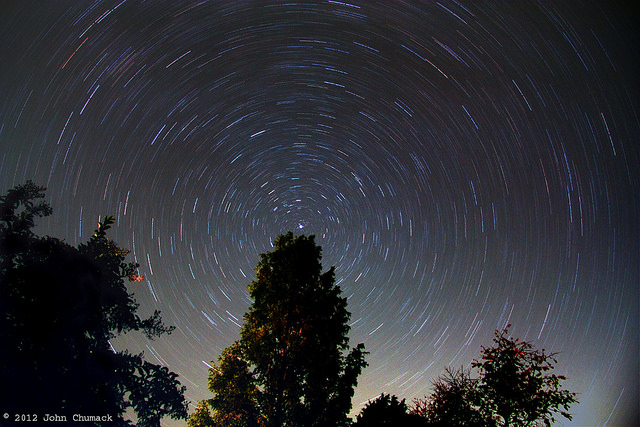This recent image from astrophotographer John Chumack shows the Earth’s natural rotation in just 30 minutes of exposure time. Polaris, the North Star, is the stationary point over a Sequoia tree in Warrenton, Virginia, USA. “The rotational speed of the Earth at the equator is about 1,038 miles per hour,” John writes. “At mid-latitudes, the speed of the Earth’s rotation decreases to 700 – 900 miles per hour. You can notice star trails “rotation” in your photographs even in as little as 1 minute exposures. I notice star trailing in about 30 seconds with a 17mm wide angle lens. But the longer you leave the shutter open the more trailing and the more dramatic the effect!”
John used a Canon Rebel Xsi, ISO 400, .17mm Lens at F4.
See more of his work at his website, Galactic Images.
Want to get your astrophoto featured on Universe Today? Join our Flickr group or send us your images by email (this means you’re giving us permission to post them). Please explain what’s in the picture, when you took it, the equipment you used, etc.


As far as I know, there are no Sequoia trees in Viginia, are there? Did you mean Warrenton, WA?
No, it was Warrenton, VA. My friends Planted this Sequoia Tree, when their house was built!
Ok, I guess that makes sense now. Thanks for the additional information.
How is it possible that trees are so sharp? No air movement for 30 minutes? Looks photoshopped for me.
The trees were not moving at all, as there was no wind that evening, now if I was on a star tracking mount, then there would be no rotation of the stars, but then the trees would blur, due to my tracking. This is one of the simplest shots in the world to do….so no need for photoshop…since I have been imaging the night sky for 25 years!
John,
Nice work. I’ve taken similar star trail photos using your method as well as using time lapse techniques. There is always a doubting thomas out there. Keep up the good work.